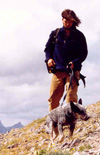 |
Damon Cargol |
In the Botany Greenhouse’s largest research room, a strange machine built mostly out of wood and pulleys and powered by a small motor, spins two vertical wheels at different speeds. While the machine is running the wheels appear quite ordinary, but there are little seedling containers embedded inside. And despite the increased gravity generated by the wheels’ motion, green sprouts are growing in towards the center.
Damon Cargol, who graduated in June, designed his centrifugal force generator with a computer assisted drawing program, but some of the tools he used to build it were decidedly pre-computer. Cargol has been collecting antique woodworking tools for years -- a hobby that started with old hand planes (he now has about 35 or 40 of them). He enjoys rebuilding old furniture in his woodworking shop, but this spring he used the skills and tools to augment his science education by creating an impressive high-gravity machine to use for his final experiment.
“Old world meets new world,” was how Cargol described this mesh of woodworking and scientific research.
Until he joined the Biology 426 class taught by Visiting Professor Kevin Delaney, Cargol had never worked with plants before. He asked the research question, “What can we learn about the effects of normal Earth gravity on plant development by exposing them to gravitational extremes?” The answer turned out to be a lot, so Cargol decided to begin with a simple observational experiment.
“Some of the things I wanted to look at were the effects on the cell wall and the distribution of phloem vessels in the stem,” he explained. (Phloem vessels distribute dissolved food from the places where the food is produced to the places where it is needed or stored.) Cargol wanted to map out these responses to a gradient of different levels of gravity between normal and high.
In his experiment, Cargol monitored the growth of his plants from seed to 14 days. Half of the seeds he used were Arabidopsis, a small flowering plant that is a member of the mustard family and is widely used as a model organism in plant biology, and the other half were fast cycling Brassica (another member of the mustard family), courtesy of Doug Ewing and the greenhouse. He put eight pots each on two wheels that spun, producing 1.4 times and 10 times Earth’s normal gravity, plus a control group of plants growing stationary alongside the machine to ensure seed viability.
The result provided more questions than answers. The Brassica on the fast wheel grew somewhat shorter and thicker than in the slow wheel but both lagged behind the stationary controls in their progression through the development stages. The Arabidopsis refused to grow in either wheel but began growing in the pots after Cargol thought the experiment had ended, when the pots had been removed and stored. Unfortunately the examination of the phloem vessels proved unfeasible in the timeframe of the class as it would have required growing the plants for a few more weeks.
The quantifiable differences between the plants were measurable but not dramatic enough to be statistically meaningful, given the relatively small sample size. “It might have all been the result of watering differences, but this is just good reason for the next person to come along and do it bigger and better,” Cargol said.
The new graduate is happy about the UW introducing him to the 400 level labs, calling them “a great way to gain experience before leaving.” He added,
“It’s amazing how more involved you can become. It’s a much more personal experience.”
(Re-printed from UniversityWeek Vol. 23 No. 34, Aug. 3, 2006)



 Together this dog and his trainer, Heath Smith, search for sign from grizzlies in Alberta, Canada. They are part of a novel and non-invasive animal tracking program started at the Center for Conservation Biology. This program is one of several at the department that conducts research to help save the lives of endangered species.
Every bit counts. Your choice to support the Department of Biology could make a big difference in how our future turns out.
Together this dog and his trainer, Heath Smith, search for sign from grizzlies in Alberta, Canada. They are part of a novel and non-invasive animal tracking program started at the Center for Conservation Biology. This program is one of several at the department that conducts research to help save the lives of endangered species.
Every bit counts. Your choice to support the Department of Biology could make a big difference in how our future turns out.